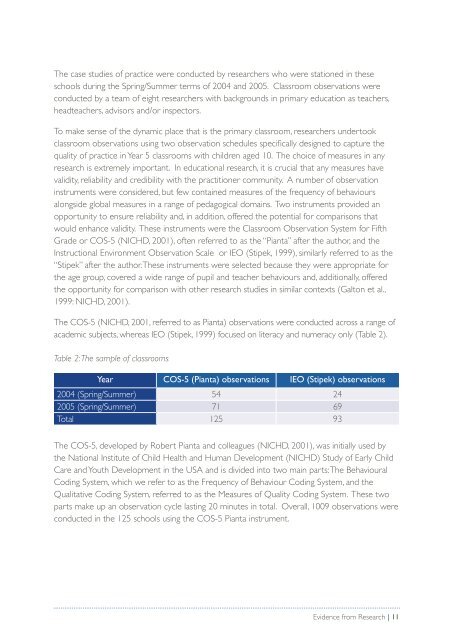Pearson-Exploring-Effective-Pedagogy-in-Primary-Schools
Pearson-Exploring-Effective-Pedagogy-in-Primary-Schools
Pearson-Exploring-Effective-Pedagogy-in-Primary-Schools
You also want an ePaper? Increase the reach of your titles
YUMPU automatically turns print PDFs into web optimized ePapers that Google loves.
The case studies of practice were conducted by researchers who were stationed <strong>in</strong> theseschools dur<strong>in</strong>g the Spr<strong>in</strong>g/Summer terms of 2004 and 2005. Classroom observations wereconducted by a team of eight researchers with backgrounds <strong>in</strong> primary education as teachers,headteachers, advisors and/or <strong>in</strong>spectors.To make sense of the dynamic place that is the primary classroom, researchers undertookclassroom observations us<strong>in</strong>g two observation schedules specifically designed to capture thequality of practice <strong>in</strong> Year 5 classrooms with children aged 10. The choice of measures <strong>in</strong> anyresearch is extremely important. In educational research, it is crucial that any measures havevalidity, reliability and credibility with the practitioner community. A number of observation<strong>in</strong>struments were considered, but few conta<strong>in</strong>ed measures of the frequency of behavioursalongside global measures <strong>in</strong> a range of pedagogical doma<strong>in</strong>s. Two <strong>in</strong>struments provided anopportunity to ensure reliability and, <strong>in</strong> addition, offered the potential for comparisons thatwould enhance validity. These <strong>in</strong>struments were the Classroom Observation System for FifthGrade or COS-5 (NICHD, 2001), often referred to as the “Pianta” after the author, and theInstructional Environment Observation Scale or IEO (Stipek, 1999), similarly referred to as the“Stipek” after the author. These <strong>in</strong>struments were selected because they were appropriate forthe age group, covered a wide range of pupil and teacher behaviours and, additionally, offeredthe opportunity for comparison with other research studies <strong>in</strong> similar contexts (Galton et al.,1999: NICHD, 2001).The COS-5 (NICHD, 2001, referred to as Pianta) observations were conducted across a range ofacademic subjects, whereas IEO (Stipek, 1999) focused on literacy and numeracy only (Table 2).Table 2: The sample of classroomsYear COS-5 (Pianta) observations IEO (Stipek) observations2004 (Spr<strong>in</strong>g/Summer) 54 242005 (Spr<strong>in</strong>g/Summer) 71 69Total 125 93The COS-5, developed by Robert Pianta and colleagues (NICHD, 2001), was <strong>in</strong>itially used bythe National Institute of Child Health and Human Development (NICHD) Study of Early ChildCare and Youth Development <strong>in</strong> the USA and is divided <strong>in</strong>to two ma<strong>in</strong> parts: The BehaviouralCod<strong>in</strong>g System, which we refer to as the Frequency of Behaviour Cod<strong>in</strong>g System, and theQualitative Cod<strong>in</strong>g System, referred to as the Measures of Quality Cod<strong>in</strong>g System. These twoparts make up an observation cycle last<strong>in</strong>g 20 m<strong>in</strong>utes <strong>in</strong> total. Overall, 1009 observations wereconducted <strong>in</strong> the 125 schools us<strong>in</strong>g the COS-5 Pianta <strong>in</strong>strument.Evidence from Research | 11


